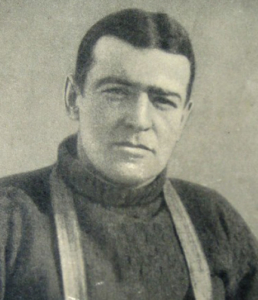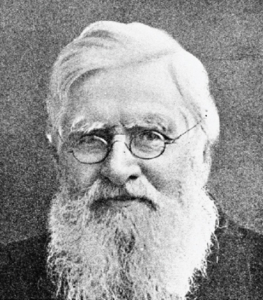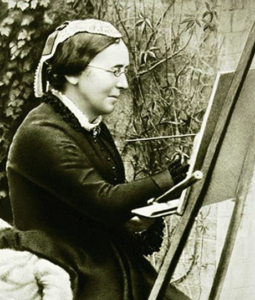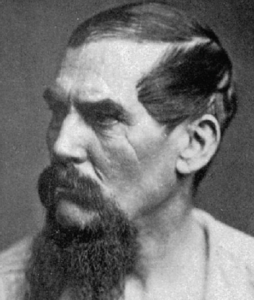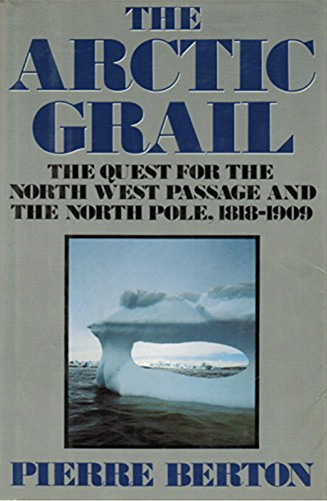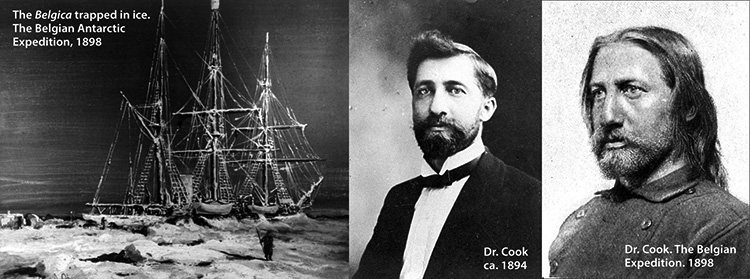Inspirations
Shackleton, Wallace, North and Burton
Only four of my explorer heroes are listed here. There are quite a few more. They come from a time before Gor-Tex clothing, GPS navigation, telecommunications, freeze-dried food and modern medicine. They voyaged to remote parts of the world where they had to be self-sufficient, highly adaptable and face the fact that they had little or no hope of being rescued if they found themselves in dire circumstances. Ernest Shackleton and his Antarctic expedition of 1914 – 1917 was the inspiration for my story which is set two decades earlier. See the PBS report on the recent discovery of the wreck of the Endurance, Shackleton’s ill-fated ship.
Sir Ernest Henry Shackleton | 1884 – 1922
Sir Ernest Henry Shackleton was a polar explorer who led three British expeditions to the Antarctic, and one of the principal figures of the period known as the Heroic Age of Antarctic Exploration. In his 3rd expedition to the South Pole, Shackleton turned his attention to the crossing of Antarctica from sea to sea, via the pole. To this end he made preparations for what became the Imperial Trans-Antarctic Expedition, 1914–17. Disaster struck this expedition when its ship, Endurance, became trapped in pack ice and was slowly crushed before the shore parties could be landed. The crew escaped by camping on the sea ice until it disintegrated, then by launching the lifeboats to reach Elephant Island and ultimately the inhabited island of South Georgia, a stormy ocean voyage of 720 nautical miles and Shackleton’s most famous exploit.
See the PBS report on the recent discovery of the wreck of the Endurance.
Alfred Russel Wallace
1823 – 1913
Alfred Russel Wallace was a British naturalist, explorer, geographer, anthropologist, and biologist. He is best known for independently conceiving the theory of evolution through natural selection; his paper on the subject was jointly published with some of Charles Darwin’s writings in 1858. This prompted Darwin to publish his own ideas in On the Origin of Species. Wallace did extensive fieldwork, first in the Amazon River basin (1848 – 1851) and then in the Malay Archipelago (1854 to 1862), where he identified the faunal divide now termed the Wallace Line, which separates the Indonesian archipelago into two distinct parts: a western portion in which the animals are largely of Asian origin, and an eastern portion where the fauna reflect Australasia.
Russel’s modesty prevented him from being as well known as he should have been. His humble origins in the class-conscious England of his day made him reluctant to claim credit for his independent thinking on natural selection. Refer to: wallacefund.info
Marianne North
1830 – 1890
Marianne North was 26 years old, she visited Kew Gardens with her father and was inspired by what she saw. It ignited her passion to see exotic flora of the tropics and other parts of the world, far away from her native England. She had a close relationship with her father. His death in 1869 left her devastated. 40 years old and unmarried, Victorian conventions didn’t stop her embarking on a series of solo trips to some of the wildest places on Earth where she where she painted nature’s verdant bounty plein air. It was a common Victorian belief that women shouldn’t travel alone without a husband or male chaperone. Women in the middle and upper classes were expected to look after their husbands and children. But Between 1871 and 1885 Marianne traveled extensively, almost always on her own. From Brazil, to Jamaica, to Japan and India, she visited 15 countries in 14 years and painted the people, places and plants that she saw. She said “the world is my compass and I will not stop”. See this wonderful video: Kew Gardens
Sir Richard Francis Burton
1821 – 1890
Sir Richard Francis Burton was a British explorer, geographer, translator, writer, soldier, cartographer, ethnologist, spy, linguist, poet, fencer, and diplomat. He was famed for his travels and explorations in Asia, Africa and the Americas, as well as his extraordinary knowledge of languages and cultures. According to one count, he spoke 29 European, Asian and African languages. Burton’s best-known achievements include: a well-documented journey to Mecca in disguise, at a time when Europeans were forbidden access on pain of death; an unexpurgated translation of One Thousand and One Nights (commonly called The Arabian Nights in English after earlier translations); the publication of the Kama Sutra in English; and a journey in 1856-1860 with John Hanning Speke as the first Europeans to visit the Great Lakes of Africa in search of the source of the Nile. John Hanning Speke was an amazing explorer in his own right.
Burton reference: Britannica
Discovery of the wreck of the Endurance
2022
On its way to the Antarctic continent the Endurance became trapped and then crushed by ice, and the ship’s party of twenty-eight drifted on an ice floe for five months. Finally reaching an uninhabited island, Shackleton, Captain Worsley, and four others sailed eight hundred miles in a small boat to the island of South Georgia, an astounding feat of navigation and courage. All hands survived this ill-fated expedition; as Worsley writes, “By self-sacrifice and throwing his own life into the balance, [Shackleton] saved every one of his men . . . although at times it had looked unlikely that one could be saved.”
It was Endurance Captain F. A. Worsley’s 1977 book “Shackleton’s Boat Journey” that inspired me to learn more about Shackleton and “The Heroic Age of Polar Exploration”.
About Marianne North
Kew Gardens video
This outstanding book by Pierre Berton presents the complete saga of the pursuit for two of the world’s greatest geographical prizes — the elusive Passage linking the Atlantic and Pacific, and the North Pole. To attain these prizes, scores of nineteenth-century expeditions battled savage cold, relentless ice and winter darkness. They were led by great explorers, certainly. But the author also credits the Inuit, whose tracking and hunting skills saved the lives of the adventurers and their men countless times.
Dr. Frederick Albert Cook, a polar explorer worth reconsidering
1865 – 1940
Dr. Cook’s life was “novelistic”, as the author Julian Sancton puts it. Remembered primarily for his disputed claims of being the first person in history to reach the North Pole in 1905 and the first to reach the summit of Mt. Denali (formerly McKinley). Cook’s true accomplishments are now being recognized. It has been my good fortune to be a part of the Frederick A. Cook Society’s efforts to set the record straight on his remarkable achievements as a physician, ethnologist, photographer and explorer from 1893 to 1905. In 2022, I built a new website for the Society and created the maps that convey the scope of his polar wanderlust. See: frederickcookpolar.org
Home | Fine Art | Polar Adventure | Exit 125 | The Creative Process | Cartoons | Web & Print | About | Contact
Email: roger@rogerdowdcreative.com
Website design by © Roger Dowd. 2025

